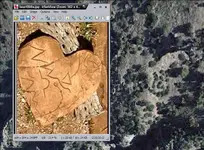Peralta,
Most of the starting points have been published, and they end up in the Superstitions. Sounds like you are following someone else's trail.
If you start at the bottom of Hieroglyphic Canyon, the map is easy to follow. The bent arrow ends up on top of the ridge line of the main mountain. The dotted line takes you down into West Boulder. Those dots match every turn in the ravine going down into the canyon.
Good luck,
Joe
Hi Joe,
Why would you start at the bottom of Hieroglyphic Canyon? What is it that brought you to this particular ridgeline? If this area truly represents the beginning of the trail how would anyone using the stone maps locate this particular spot?
I am just trying to understand why you would choose this canyon ridge when you know where the three largest man made hearts are located in the state of Arizona. You know, just north of the Gila River where Manje had made a comment** about being able to see Casa Grande with Father Kino's telescope*(he was just a tad more to the east than Heart Mnt.).
Interesting that when one is located at Casa Grande (on an exceptional clear day) you can see the two hearts located on Heart Mountain 24 miles away with an unobstructed view, Casa Grande's elevation is 1,423' and Heart Mountain's two hearts are at an elevation of 2,540'. Of course you would have to use a set of field glasses comparable to Father Kino's telescope.
The Hearts were designed to be seen from Casa Grande and this is where the trail starts. Father Kino was aware of this point (Casa Grande) as was Frey Marcos de Niza (see below) for they were both excellent Navigators and knew exactly where they were located.
One must have well known permanent landmarks to work with to find the trail. Everyone back in the day knew exactly where Chichiticale (Casa Grande) was located. Many of today's historians have botched that one up. A few actually have figured it out; Find and read an English version of this awesome well researched work. The Stone Maps require the three hearts and Casa Grande as they are the foundation of the beginning of the trail!
FRAY MARCOS DE NIZA: IN PURSUIT OF FRANCISCAN UTOPIA IN AMERICAS
BY MICHEL NALLINO
Kino’s Historic Memoir of Pimeria Alta: a contemporary account, Volume 3
by Eussebio Francisco Kino
Book IV, Chapter 1
That map which I brought with me to the Indies and even to these new conversions with its little treatise and instruction or explanation for it is cosmographical, geographical, horological and horographical, nautical and geometrical etc; page 330
Horology (from Greek:
ὥρα, "hour, time" and Greek: λόγος, logos, "study, speech"; lit. the study of time) is the art or science of measuring time. Clocks, watches, clockwork, sundials, clepsydras, timers, time recorders and marine chronometers are all examples of instruments used to measure time.
Horography
- (n.) An account of the hours.
- (n.) The art of constructing instruments for making the hours, as clocks, watches, and dials. Kino had made two of these instruments before making his trip to California. One went to China with another Jesuit Brother.
cosmography
- 3 dictionary results cos·mog·ra·phy
cosmography / / [koz-
mog-r
uh-fee]
–noun, plural -phies.
1. a science that describes and maps the main features of the heavens and the earth, including astronomy, geography, and geology.
2. a description or representation of the main features of the universe.
Origin:
1350–1400; ME < Gk
kosmographía description of the world.
—Related forms
.0cos·mog·ra·pher, cos·mog·ra·phist,
noun
cos·mo·graph·ic/ˌ [koz-m
uh-
graf-ik]
cos·mo·graph·i·cal,
adjective
cos·mo·graph·i·cal·ly,
adverb
Kino’s Historic Memoir of Pimeria Alta: a contemporary account, Volume 3
by Eussebio Francisco Kino
Book IV, Chapter 1
But now already thanks to His Divine Majesty with various expeditions and three in particular of one hundred and fifty one hundred and seventy and two hundred leagues which I have made from here to the north of Nuestra Senora de los Dolores I have discovered with all minute certainty and evidence with mariner's compass and astrolabe in my hands that California is not an island but a peninsula or isthmus and that in thirty two degrees of latitude there is a passage by land to California and that only to about that point comes the head of the Sea of California the large volumed rivers which in the following chapters will be mentioned emptying into the head. Page 334
LATITUDE THIRTY ONE AND A HALF DEGREES At midday we took the altitude of the sun with the astrolabe and found it to be fifty two degrees which adding to it the six and a half of south declination of that day made fifty eight degrees and a half. The complement of ninety degrees is thirty one degrees and a half and this was the altitude of the pole or geographical latitude in which we found ourselves. 467
Chapter VIII
The casa grande is a four story building as large as a castle and equal to the largest church in these lands of Sonora It is said that the ancestors of Montezuma deserted and depopulated it and beset by the neighboring Apaches left for the east or Casas Grandes (a different group of ruins located farther to the southeast) and that from there they turned towards the south and southwest finally founding the great city and court of Mexico.
Close to this casa grande there are thirteen smaller houses somewhat more dilapidated and the ruins of many others which make it evident that in ancient times there had been a city here On this occasion and on later ones I have learned and heard and at times have seen that further to the east north and west there are seven or eight more of these large old houses and the ruins of whole cities with many broken metates and jars charcoal, etc.
These certainly must be the Seven Cities mentioned by the holy man Fray Marcos de Niza who in his long pilgrimage came clear to the Bacapa rancheria of these coasts which is about sixty leagues southwest from this casa grande and about twenty leagues from the Sea of California. The guides or interpreters must have given his Reverence the information which he has in his book concerning these Seven Cities although certainly at that time and for a long while before they must have been deserted.
( 123 Bancroft's mistrust of the A fanes leads him here into needless error He states in North Mexican States and Texas vol i 259 that it is implied by the Afanes that Kino named these two rancherias But the Afanes clearly asserts this fact and does not merely imply it. I believe that the Favores is the only authority which identifies these rancherias with the native names. 129 On the Manuscripts of the Luz de Tierra Incognita there is a drawing of the Casa Grande presumably by Manje p 57 There is also one made in 1776 on one of the original diaries of Juan Bautista de Anza.
Father Kino evidently had more knowledge of the Coronado expedition than Bancroft gives him credit for. North Mexican States and Texas vol i 259)
*
Southwest Navigation Methods of Eusebio Francisco Kino, S. J. Author(s): Ronald L. Ives Source: Arizona and the West, Vol. 2, No. 3 ( Autumn, 1960), pp. 213-243Published by: Journal of the Southwest {Telescope mentioned on page 217 first paragraph and page 218 all of second paragraph}
**Father Kino's 1697 Entrada to the Casa Grande Ruin in Arizona: A Reconstruction Author(s): Ronald L. Ives Source: Arizona and the West, Vol. 15, No. 4 (Winter, 1973), pp. 345-370 Published by: Journal of the Southwest
Manje’s comment regarding Casa Grande, bottom paragraph page 357 and page 358 the first sentence.
Thanks in advance,
Ellie Baba




